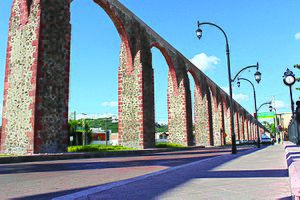Aqueduct of Querétaro facts for kids
The Aqueduct of Querétaro is a famous structure in the Mexican city of Querétaro. It was built in the 1700s. This amazing aqueduct is a symbol of the city. It is also one of the biggest aqueducts in all of Mexico.
The aqueduct is part of Querétaro's historic center. This area is a UNESCO World Heritage Site. The aqueduct is about 1,280 meters (4,199 feet) long. It has 74 arches. These arches are very tall, reaching an average height of 28.5 meters (93.5 feet).
The American Society of Civil Engineers has called it an International Historic Civil Engineering Landmark. This means it's a very important engineering achievement worldwide.
Contents
Building the Querétaro Aqueduct
Why the Aqueduct Was Needed
In the 17th and 18th centuries, Querétaro was a rich and beautiful city. It was one of the most important towns in New Spain (colonial Mexico). However, the city had a big problem. It didn't have enough clean drinking water.
The old water pipes carried dirty water. This water was often polluted by nearby butcher shops. Even the Capuchin nuns, who needed clean water for their daily duties, complained. They asked the Marquis, Juan Antonio, for help.
Querétaro had plenty of river water, but it wasn't clean. The city needed a new, healthy water system.
The Marquis and the Water Source
Juan Antonio of Urrutia and Arana, known as the Marquis, decided to solve the water problem. He told the city council about his plan. The council members promised to help raise money. They aimed to collect $25,000 from the people living in the city.
The Marquis searched for the best water source. He found a good spot called Ojo de Agua del Capulín. This place was in La Cañada, a town near Querétaro. It was named after a capulín tree.
At first, the water flow from this source was small. But thanks to the Marquis's efforts, the flow increased a lot. It grew to about 30 liters (8 gallons) per second.
Designing the Water System
An engineer named Miguel Mendoza carefully studied the land. He found that 18 different springs flowed into Ojo de Agua del Capulín. Because of this, the Marquis decided to build a large pool. This pool would collect all the water from these springs.
From this pool, the water would travel through a canal to Querétaro. The pool itself was not very fancy. But the Marquis added a statue of Saint Anthony to its front. This statue is no longer there today.
Once the water tank was finished, a fence was built around it. This fence was tall enough to protect the water. The key to its entrance was given to a city councilman.
The Long Canal and Arches
The water then flowed through a long canal made of lime and stone. This canal was an amazing piece of work. It was about two leagues (roughly 10 kilometers or 6 miles) long.
The canal twisted and turned, following the land. Sometimes it was visible above ground. Other times, it went deep into ravines or disappeared from view. It ran in different directions to get the water where it needed to go.
Finally, the canal reached the actual aqueduct. This part of the aqueduct crosses a large valley. It stretches from the western hill of La Cañada to the La Cruz nunnery. The famous arches were built specifically for this nunnery. They allowed the water to flow using gravity.
Water Arrives in the City
On October 22, 1735, the water finally reached the city. It arrived at a special water box in the small square of La Cruz. From this box, the water was later sent to public fountains. This happened three years later, through different routes around the city.
The water box is the end point of the aqueduct. It has a platform that serves as the base for a fountain. A reddish stone wall stands behind it. On this wall, there is a stone figure of a lion. Water flowed out of the lion's mouth.
Above the lion, there was a royal coat of arms. An image of Our Lady of the Pillar, or the Blessed Virgin Mary, also crowned the piece.
Completion and Celebration
The entire aqueduct project was finished on October 17, 1738. The total cost was $125,000. The Marquis donated a huge part of this money, over $88,000. This money came from his wife's fortune. The rest of the cost was shared among the city's residents.
To celebrate this special achievement, a mass of thanks was held on October 29, 1738. There were also many other celebrations. These lasted for more than two weeks! They included parades, plays, dances, fireworks, and bullfights.
See also
 In Spanish: Acueducto de Querétaro para niños
In Spanish: Acueducto de Querétaro para niños


